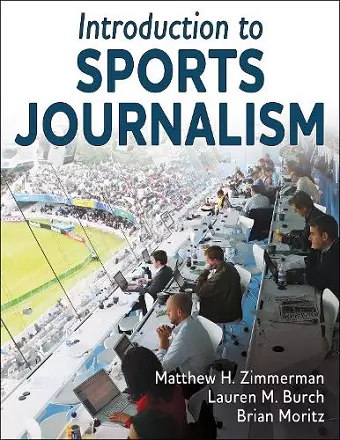Introduction to Sports Journalism
Lauren M Burch author Matthew H Zimmerman author Brian Moritz author
Format:Paperback
Publisher:Human Kinetics Publishers
Published:7th Oct '24
Should be back in stock very soon

Sports journalism has seen massive upheaval in recent years. Today’s 24/7 sports networks, streaming services, and social media platforms bring sports coverage and live events to consumers anytime, anywhere. But despite the increase in the number of media outlets and the speed by which news is delivered and consumed, the basic tenets of sports journalism remain, albeit with a few new wrinkles.
Embracing this dynamic, Introduction to Sports Journalism provides students with the practical knowledge and tools to succeed in the evolving field of sports journalism. While other texts repeat the “sports journalism is changing” refrain, Introduction to Sports Journalism sheds light on how and why it’s changing. Through these discussions students are challenged to formulate their own perspectives on contemporary sports journalism, journalistic expression, and how these concepts fit in today’s evolving media and societal landscapes.
The text begins with an overview and history of sports journalism and traditional media. Also discussed is the impact of today’s nontraditional journalists: the bloggers and videographers outside traditional media channels.
The core of the text then focuses on developing practical skills required to work in the sports journalism field, including knowing how and what to write to craft compelling stories. Much attention is paid to analytics, what they are, their variations across sports, and how to interpret and use them effectively. Also featured are digital media (blogs, podcasts, and social media platforms) and the technological tools used to create content.
Sports journalism and public relations often overlap, and the text explains the nuances of the respective functions. Public relations tools such as media guides and game notes are presented, as well as a section on crisis communication.
The pressure to “break the story” can tempt even the best journalist to plagiarize or fabricate stories or skip fact checks. The text covers journalism ethics and provides best practices for avoiding traps. Racial and gender bias and the importance of providing equitable coverage are also discussed. Additionally, legal issues such as copyright, privacy, discrimination, defamation, reporter’s privilege, and first amendment rights are addressed.
The book concludes with a discussion of career paths and challenges facing the industry. The landscape is changing and, in response, the authors provide...
ISBN: 9781492598435
Dimensions: unknown
Weight: 544g
184 pages
New edition